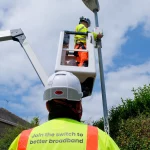2023 H1 – UK Full Fibre Broadband Coverage Rises to 53 Percent

The latest biannual summary of UK fixed broadband coverage for H1 2023 has found that “full fibre” (FTTP) ISP networks have surged to reach 52.77% of premises (up from 45.13% in H2 2022) and 76.22% are within reach of “gigabit” speeds (up from 72.66%). Read on for details of England, Wales, Scotland and N.Ireland.
At present virtually all of this new gigabit (1000Mbps+ or 1Gbps+) class connectivity is coming from Fibre-to-the-Premises (FTTP) based networks via Openreach (BT), Virgin Media, KCOM, Hyperoptic, CityFibre, CommunityFibre, G.Network, Netomnia, Gigaclear and many others (Summary of Full Fibre Builds).
The reason why gigabit coverage is so much higher than full fibre is because the 14.3 million premises covered by Virgin Media’s older Hybrid Fibre Coax (HFC) network were upgraded to gigabit-capable DOCSIS 3.1 technology between 2019 and the end of 2021. But gigabit coverage now grows at a slower pace because a lot of urban focused FTTP builds are overbuilding that HFC.
Advertisement
Most of the progress on gigabit-capable coverage during 2023 is still down to commercial investment in FTTP, often with only a little support from the Government’s various voucher schemes. But the £5bn Project Gigabit (F20) programme and its subsidised rollout contracts are starting to have a tiny impact on this, which we expect to grow over the next few years.
Meanwhile, those still stuck in sub-10Mbps areas will, for the time being, be left with little option but to either try harnessing the flawed 10Mbps Universal Service Obligation (USO), take a satellite connection (Starlink is good, if you can afford it) or wait for a fixed line upgrade. People taking the USO are being promised speeds of over 10Mbps (often via 4G rather than fibre), but some of those will find that they live in areas where not even the USO can cover the colossal upgrade costs (here and here). The government are still examining support options for remote premises.
Listed below is the latest independent modelling from Thinkbroadband to July 2023 (H1 – 2023). We should point out that the figure for ‘Under 10Mbps‘ doesn’t reflect 4G mobile coverage, which plays a part in the official USO but isn’t included in TBB’s mapping work. Sadly, it’s incredibly difficult to do an accurate model for mobile coverage, especially in terms of a specific performance level.
Fixed Broadband Network Availability H1 – 2023
Advertisement
| Area | 30Mbps+ | Full Fibre | Gigabit | % Under 10Mbps |
| England | 97.90% (97.78%) | 52.11% (44.21%) | 77.09% (73.63%) | 0.69% (0.71%) |
| UK | 97.61% (97.40%) | 52.77% (45.13%) | 76.22% (72.66%) |
0.94% (1.02%) |
| Wales | 96.92% (96.61%) | 49.45% (41.54%) | 63.21% (57.07%) | 1.59% (1.75%) |
| Scotland | 95.61% (95.28%) | 47.81% (41.75%) | 69.77% (66.80%) | 2.49% (2.66%) |
| N.Ireland | 96.64% (94.37%) | 92.27% (88.31%) | 93.01% (89.19%) | 2.10% (3.65%) |
NOTE 1: Much of the gigabit coverage is coming from Virgin Media’s existing HFC cable network, although Openreach, Hyperoptic, Gigaclear, Cityfibre and many others all have big “full fibre” (FTTP) expansion plans. But there’s a lot of overbuild between HFC and FTTP, so future progress post-2021 has been slower now that VM have completed their upgrade.
NOTE 2: It’s very important to remember that Government / political coverage targets, like 85% for gigabit by 2025, reflect a national average, which can of course be better or worse for some areas (e.g. some may achieve higher coverage, while others could be well below that).
Take note that each devolved region (Scotland, Wales etc.) may have its own policy and targets, which all feed into the central UK figure. For example, while Northern Ireland may be behind on superfast speeds, their full fibre coverage is far ahead of other regions – exceeding 90% – and they’ll also be one of the first to achieve near universal coverage of gigabit speeds.
We also think it’s worth highlighting how much of an impact newer alternative networks (AltNets) are having on all this. Excluding coverage by Openreach, KCOM and Virgin Media, rival AltNets alone were found to have covered 23.64% of the UK with FTTP by H1 2023 (up from 18.20% in H2 2022). This breaks down to 25.04% in England (up from 19.29%), 6.81% in Wales (up from 3.79%), 19.85% in Scotland (up from 16.74%) and 23.45% in Northern Ireland (up from 15.74%). But the overall coverage impact will be lower due to overbuild, particularly in urban areas.
As stated earlier, this data is an estimate and should be taken with a pinch of salt, not least because it won’t always reflect the very latest real-world position. But it’s still one of the best and most up-to-date gauges that we have for checking against official claims (official figures tend to be a tiny bit higher than TBB’s data due to differences in data modelling etc.).
Mark is a professional technology writer, IT consultant and computer engineer from Dorset (England), he also founded ISPreview in 1999 and enjoys analysing the latest telecoms and broadband developments. Find me on X (Twitter), Mastodon, Facebook, BlueSky, Threads.net and Linkedin.
« UK Disappoints in Global Comparison of 5G Mobile Broadband Speeds





















































That’s actually quite impressive given where we were only a few years ago.
its almost like everything BT told us was a lie and when regulatory intervention was suggested they managed to pull their finger out… that and the fantastic work of some altnets in creating competition
Wasn’t aware they were threatened with regulatory action if they didn’t roll full fibre. What they were threatened with were a bunch of altnets using their duct and pole assets to build full fibre and take their customers.
The regulatory action had already happened: first the introduction of PIA then Openreach being forced to modify the product to allow it to actually work as intended leaving altnets able to build at close-ish to Openreach’s own costs.
Competition has a way of getting things moving.
They are far, far from perfect but it’s easy for an altnet with no sustainable business case taking PE money to quickly cover the easy 80% in existing ducts etc and then selling out (hopefully) at a chunk profit
We were late to get ADSL here in Derry (May 02) but since then and since we seemed to have got VDSL/FTTP very quickly, and also have Virgin covering most of the town. Netomnia now are here too. Almost spoilt for choice when others are stuck in dark ages.
Other way around here I think, ADSL came in 2000 and that is the way it stayed for years, FTTC came about 9 years ago and now and in 2021 saw FTTP being laid by an Alt net. There were a couple of roads in the city with Openreach FTTP before that for some reason.
Now the Altnet have almost done their build and Openreach is trying to catch up.
The problem is getting people to change, a lot is happy with what they have and see no reason to change.
Ad47uk:
I have FTTP and my town is now an FTTP only area by Openreach. So if you change ISP you are forced to take FTTP, not that thats a bad thing.
@K, I don;lt think it will too long before that starts happening here, saying that there is still a large chunk of the city that don’t have Openreach fibre. I would say another 2-3 years and people will be forced to FTTP.
My problem is with this is providers upselling, i know a few people with Openreach FTTp in different places and with different suppliers, EE, Talk Talk, and sky, and they have all said about these providers trying to push higher speed packages. Ee seems to be the worst with emails almost every month.
I also don’t like the fact that people who rely on their home phone will lose the reliability of it. That is suppose to be progress.
The last thing is when Openreach do force people to FTTP, people will not look around for other networks, so Alt nets will lose out even more.
I am using Zzoomm and it is fine, even if it did take me a long time to decide, price was what made me jump to FTTP, it was cheaper than what Plusnet was offering me on FTTC and others were only a couple of quid cheaper, so may as well go to fibre.
Only a 12 month contract as well so that is good, when my contract ends I will go to 150Mb/s as I am on 500Mb/s at the moment unless Zzoomm give me a good offer to stay on this speed.
Ad47uk:
You are right about being pushed to higher speeds. BT business wont supply me with anything slower than 150mb, not even 36mb via FTTP to my studio. I used to have Plusnet FTTC in my studio for around £25/month inc vat, but now i would have to spend a minimum of £35+vat/month if i wanted BT. Have 900mb in my house though and am now using wifi extenders to my studio so saving money that way.
@K, plusnet will go to a lower speed if you are already with them and change to FTTP, as they offered me 36Mb/s for about £26 I think, but they wanted me to sign up for a 24 contract, I did not think it was any advantage to FTTC for me and I did try to get them to give me a offer of £26 a month on FTTc on a 18 month contract, but they would not move, 24 months yes, but not 18.
Plusnet do offer 74Mb/s for new customers for £24.,99, but on a 24 month contract. My view was if I was going to go through the hassle of going for FTTP, then I may as well take up the offer Zzoomm gave me for a 12-month contract.
Plusnet will do a 38 – 40Mb FTTC package for £23, but again 24-month contract .
I presume if people are forced off FTTC, the ISP will have to put them on a FTTP lower speed if they insist at a decent price. They can’t force people to pay more for speeds they don’t want.
That is why mobile phone providers give 5G access at the same price as 4G as they know a lot of people would not pay extra for 5G. I am with Smarty for mobile and I get emails from them now and again trying to get me to up my data and saying I have access to 5G. Which I don’t as my phone is 4G and 5G here even from Three is not good.
I have just been on the BT website and put in my postcode and a house number and it came up with 36Mb/s on Full fibre at £31 a month, that is a lot just for 36Mb.s, but not a surprise from BT. But 150Mb/s is cheaper at £29,99 and no upfront costs, which is £29.99 on the 36Mb/s package.
I really don’t get it, why are they trying to get people onto faster speed packages? It is the same technology and yet faster speeds are cheaper. Not that BT is cheap, never have been
The leaflet I had though the door a couple of weeks ago from BT, offered me BT TV and Netflix, plus 150Mb/s broadband for £39.99. i wonder if I contacted them and say knock out the TV and netflix and put the price down of the 150Mb/s would they have done that? No BT is all about selling their other stuff to people these days.
I have said it for years, even in the days of ADSL, I just want a connection to the net at the cheapest price, well kind off. Speed is important to a certain degree, and so is reliability
But you know what I mean, as long as I can do what I need to do, then I am not bothered about speed and don’t want any add-ons. That was one thing about plusnet they did not hassle me, they did ask once about their TV package, but when I told them I don’t have a TV licence they never bothered again., I did have their mobile phone service for a while, but they did not hassle me to get it, nor after I changed to Smarty. Plusnet could not get me to change to a faster speed as i could not get any faster until December last year.
Figures on https://labs.thinkbroadband.com/local have been updated with the 1st July ones, i.e. based on coverage database held at 23:59 on 30th June 2023
Change is that UK is up from 52.77% FTTP coverage a week ago to 52.89%. Lots of work tracking down footprints, and lots of overlapping again this week.
Only Virgin available where I live in Wakefield, but simple enquiries lead to unending and unwanted sales calls that are so aggressive we felt thoroughly bullied, whilst we hear that customer support for people who do sign up is non existent. Way too expensive at the moment.
Still waiting in Lincolnshire. Upp have been seen laying cables in and around the village but they won’t talk to anyone about what’s going on. Voucher scheme says 3 providers available in my postcode (one is Openreach) and the other 2 have confirmed via their own postcode checkers that we’re not in your area. Openreach are planned to by 2026 but not getting my hopes up.
Where in Lincolnshire?
Burgh le Marsh & Wainfleet